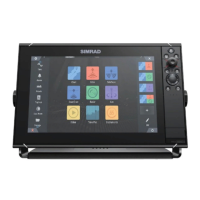Range
The range setting determines which water depth that is visible on the screen.
Ú
Note: Setting a deep range in shallow water may cause the system to lose track of the
depth.
Preset range levels
Select a preset range level manually from the menu.
Auto range
In auto range, the system automatically displays the whole range from the water surface to
the bottom.
Auto is the preferred setting for fish finding.
Select the range option and then the auto option in the menu.
Custom range
This option allows you to manually set both upper and lower range limits.
Set a custom range by selecting the range menu option and then the custom option.
Ú
Note: Setting a custom range puts the system in manual range mode.
Frequencies
Two frequencies are supported. 800 kHz provides the sharpest image without sacrificing
range. While 455 kHz can be used in deeper waters, or for expanded range capabilities.
Contrast
Determines the brightness ratio between light and dark areas of the screen.
Ú
Note: We recommend that you use the auto contrast option.
Palettes
Used for selecting the image's color palette.
FishReveal
Select FishReveal to display fish arches in the image.
When FishReveal is enabled, the menu expands to include FishReveal options.
Gain
Controls the sensitivity of the FishReveal data on the DownScan image. Increasing gain
shows more detail on the screen. Decreasing gain displays less. Too much detail clutters the
screen. If the gain is set too low, weak fish arch data might not be displayed.
Color
Adjusts the colors of the fish arch data to help differentiate them from other targets.
Adjusting the color can help separate fish and important structures on or near the bottom
from the actual bottom.
TVG
Wave action and boat wakes can cause onscreen clutter near the surface. The TVG (Time
Variable Gain) option reduces surface clutter by decreasing the sensitivity of the receiver near
the surface.
Palette
Select between several display palettes optimized for a variety of fishing conditions.
Ú
Note: Palette choice is often a user preference, and may vary depending on the fishing
conditions. It is best to select a palette that provides good contrast between the image
details and FishReveal arches.
84
DownScan | NSS evo3S Operator Manual

